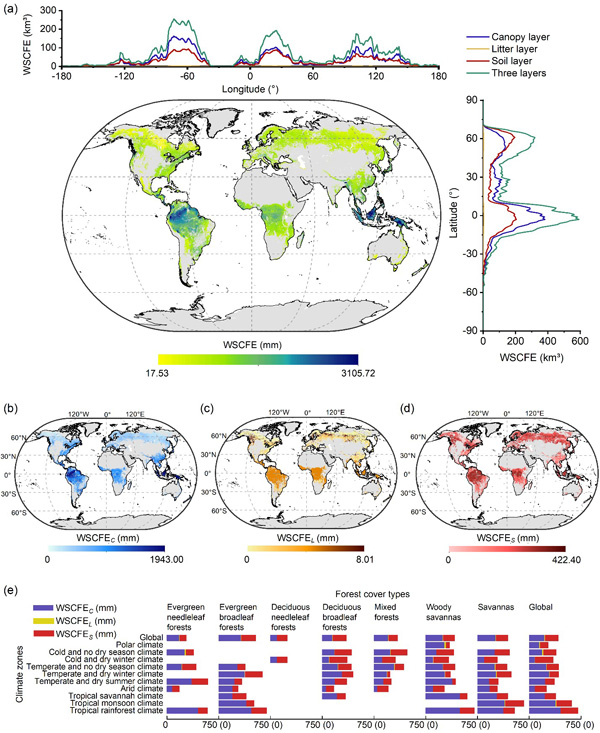Researchers Provide a Global Synthesis of Multi-factors Affecting Water Storage Capacity in Forest Canopy, Litter and Soil Layers
Water storage capacity of the forest ecosystem refers to the precipitation that can be intercepted and stored by the forest canopy, litter, and soil layers, accounting for more than 25% of the terrestrial water cycle. On a global scale, the water storage capacities of different forest layers are affected by different natural driving factors, but their global patterns have not been fully understood.
Recently, based on the literature data extracted by the meta-analysis method and the spatial data such as MODIS land cover data and Koppen climate classification, Prof. SHI Wenjiao’s team at IGSNRR quantified three important water storages of the canopy layer, litter layer, and soil layers in the forest ecosystems related to water regulation services, and revealed the effect of individual drivers and multiple drivers on each storage layer to figure out the contribution of each driver.
The results showed that the global forest water storage capacity decreased from low latitude to high latitude, from coast to inland, and from mountains to plains. Overall, the five types of driving factors (terrain factors, climatic factors, forest attributes, litter characteristics, and soil physical properties) explained 89% variance of the water storage capacity. Among them, climate factors had the greatest and most positive influence on forest water storage capacity. In different forest types, precipitation, tree height, and soil capillary porosity showed synergic relationships with water storage capacity, while evapotranspiration had an inhibitory effect on water storage capacity in all forest types.
The quantification of three important water storages provides a basis to delineate global water regulation zones. The key factors affecting forest water storage capacity should be considered in the formulation of protection policies for ecological functional areas. This study also provides data for the calibration of terrestrial hydrological models and the analysis of factors affecting forest water storage at the global scale. It plays a vital role in simulating and predicting the water storage capacity of forest ecosystems from point to space in a more accurate way.
This research was published in “Geophysical Research Letters”, a TOP geoscience journal. The corresponding authors of the paper are Prof. SHI Wenjiao and Prof. TAO Fulu, and the first author is visiting postgraduate LIU Yexuan. This research is a new progress of forest ecosystem water storage capacity on a global scale made by Prof. SHI’s team after the ecosystem services research related to forest – water on regional [Heterogeneity of water-retention capacity of forest and its influencing factors based on meta-analysis in the Beijing-Tianjin-Hebei region. Journal of Geographical Sciences, 2021, 31(1), 69-90] and national [Large spatial variations in the distributions of and factors affecting forest water retention capacity in China. Ecological Indicators, 2020, 113, 106152; Estimations of forest water retention across China from an observation site-scale to a national-scale. Ecological Indicators, 2021, 132, 108274] scales.
Article: Liu, Y., Shi, W.*, Tao, F.*, Shi, X., Fu, B. (2023). A global synthesis of multi-factors affecting water storage capacity in forest canopy, litter and soil layers. Geophysical Research Letters. https://doi.org/10.1029/2022GL099888 (DOI: 10.1029/2022GL099888).

Figure: Global water storage capacity patterns in (a) three layers, (b) canopy layer, (c) litter layer, (d) soil layer, and in (e) different forest types and different climate zones. Charts on the top and right of (a) show the longitudinal and latitudinal distributions of water storage capacity, respectively. (Image by Prof. SHI's team)
Download attachments: